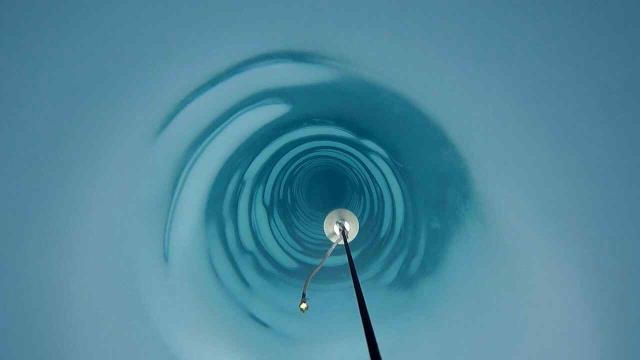Using a hot-water drill, British scientists have dug a 2,151.89m borehole through the Antarctic ice sheet. The comically long ice hole is the largest ever for West Antarctica, and it’s meant to improve our understanding of climate-related sea level rise.
This project, run by the British Antarctic Survey, is called “Bed Access, Monitoring and Ice Sheet History,” or BEAMISH. It began 20 years ago and its scientists tried, unsuccessfully, to drill a hole in 2004. All these years of hard work and planning, it now appears, have finally paid off.
On January 8, a crew of 11 BEAMISH team members, after 63 hours of continuous drilling, finally reached down to the sediment below, according to a BAS press release. From top to bottom the hole measures 1.3 miles (2,152 meters or 2.1 kilometers), which is the length of 20 football fields placed end-to-end.
“I have waited for this moment for a long time and am delighted that we’ve finally achieved our goal,” BAS lead scientist Andy Smith said in a statement. “There are gaps in our knowledge of what’s happening in West Antarctica and by studying the area where the ice sits on soft sediment we can understand better how this region may change in the future and contribute to global sea-level rise.”
This ice hole is now the deepest ever made with a hot-water drill in West Antarctica, the BBC reports. BEAMISH is currently working at the Rutford Ice Stream, a fast-flowing West Antarctic ice stream. As for the deepest hole of any kind ever drilled in Antarctica, that distinction goes to the 2,221.99m-deep (2,414 meters) borehole forming the IceCube Neutrino Observatory near the South Pole.
Once they reached the bottom of the ice sheet to the sediment below, BEAMISH team members sent various instruments down through the bore hole to record ice temperature, water pressure, and to detect any deformations within the ice sheet.
As noted, a primary concern of the BEAMISH project is to learn more about sea level rise. Scientists are currently struggling to learn why sea level rise is happening faster than expected, and how long this process might continue. As the BEAMISH website explains, the project seeks to understand “the past behaviour of the West Antarctic Ice Sheet…[and] the flow of the fast ‘ice streams’ that drain it. Through measurements at the ice surface, and by drilling to the bed of Rutford Ice Stream, we will find how long ago the ice sheet last disappeared completely, and how water and soft sediments underneath it helped the ice move fast on its journey to eventually melting in the sea.”
Keith Makinson, a physical oceanographer at BAS, said warmer ocean waters are chipping away at many of West Antarctica’s glaciers.
“What we’re trying to understand is how slippery the sediment underneath these glaciers is, and therefore how quickly they might flow off the continent into the sea,” he said in the BAS statement. “This will help us determine future sea level rise from West Antarctica with more certainty.”
On January 22, BEAMISH drilled a second ice hole, and there are now plans for another about a kilometer away. The team will continue to work in Antarctica until mid-February.
[referenced url=”https://gizmodo.com.au/2018/12/antarctic-scientists-are-about-to-drill-into-one-of-the-most-isolated-lakes-on-earth/” thumb=”https://i.kinja-img.com/gawker-media/image/upload/t_ku-large/zfolximjlziptzhkdymt.jpg” title=”Antarctic Scientists Are About To Drill Into One Of The Most Isolated Lakes On Earth” excerpt=”Buried beneath 1,219.20m of Antarctic ice lies Lake Mercer, a subglacial body of water that formed thousands of years ago and has been long separated from the rest of the world. A project to explore this lake—and its mysterious contents—is finally set to begin later this month.”]
With summer in full force in Antarctica, scientists are hard at work. In addition to this project, there’s the Subglacial Antarctic Lakes Scientific Access (SALSA) team, which, managed to drill a 1,219.20m hole in late December, reaching a body of water known as Lake Mercer below.
‘Tis the season to be making ice holes, I guess.
